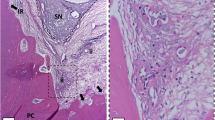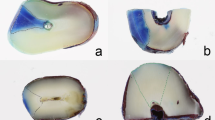Abstract
Preservation of pulpal health is the primary prerequisite for successful application of laser systems in the hard tissue management of vital teeth. The purpose of this study was to investigate the short and long-term pulpal effects to cavity preparations in healthy human teeth using carbon dioxide (CO2) laser. A total of seven, healthy, third molars that were scheduled to be removed due to space problems were used. After the laser drilling, the occlusal cavities were closed temporarily, and the teeth were extracted 7 days (n=5) and 3 months (n=2) after the operation. The specimens were fixed, decalcified, subdivided and processed for light and transmission electron microscopy. Seven days postoperatively all the five teeth that had been irradiated with the CO2 laser did not reveal any pathological changes in the pulpo-dentine complex. Three months postoperatively the two teeth that were prepared with the laser showed subtle but distinct apposition of tertiary dentine that was lined with intact odontoblasts. One of the specimens at 3 months revealed the presence of a mild, but very circumscribed, pulpal infiltration of chronic inflammatory cells subjacent to the cavity preparation. The latter is unlikely to be due to a direct effect of the laser irradiation but a possible consequence of microleakage of oral antigens and/or other tissue-irritating molecules through the temporary restoration and the remaining dentine thickness (RDT). Although these preliminary histological results suggest that the CO2 laser under investigation induced only minimal response of the dentine-pulp complex when used as a hard-tissue drilling tool, with specific energy settings, pulse duration within thermal relaxation time and emitting radiations at 9.6 μm of wavelength, larger clinical trials involving various types of teeth are necessary to reach definite conclusions for large-scale clinical application of the laser device.



Similar content being viewed by others
References
Einstein A (1917) Zur Quantentheorie der Strahlung (On quantem theory of radiation). Physik Z 18:121–128
Schawlow AL, Townes CH (1958) Infrared and optical masers. Phys Rev 112:1940–1949
Maiman TH (1960) Stimulated optical radiation in ruby. Nature 187:493–494
Goldman L, Hornby P, Meyer R, Goldman B (1964) Impact of the laser on dental caries. Nature 203:417
Goldman L, Gray JA, Goldman J, Goldman B, Meyer R (1965) Effect of laser beam impacts on teeth. J Am Dent Assoc 70:601–606
Stern RH, Sognnaes RF (1964) Laser beam effect on dental hard tissues. J Dent Res 43:873
Stern RH, Renger HL, Howell FV (1969) Laser effects on vital dental pulps. Br Dent J 127:26–28
Hoexter DL (2001) Latest advances in laser systems and periodontal surgery. Dent Clin N Am 45:207–212
Kimura Y, Wilder-Smith P, Matsumoto K (2000) Lasers in endodontics: a review. Int Endod J 33:173–185
Sulewski JG (2000) Historical survey of laser dentistry. Dent Clin N Am 44:717–752
Willenborg GC (1988) The future of lasers in clinical dentistry. J Dent Pract Admin 5:141–147
Willenborg GC (1989) Dental laser applications: emerging to maturity. Lasers Surg Med 9:303–313
Jastrow R (1983) How to make nuclear weapons obsolete, 1st edn. Little Brown, Boston, pp 83–88
Anderson RR, Parrish JA (1983) Selective photothermolysis: precise microsurgery by selective absorption of pulsed radiation. Science 220:524–527
Visuri SR, Walsh JT, Wigdor HA (1993) Erbium laser ablation of dental hard tissues: effect of water cooling. Laser Surg Med 18:294–300
Hibst R, Keller U (1989) Experimental studies of the application of Er:YAG laser on dental hard substances: I. Measurement of the ablation rate. Laser Surg Med 9:338–344
Keller U, Hibst R (1989) Experimental studies on the application of the Er:YAG laser on dental hard substances. II Light microscopic and SEM investigations. Laser Surg Med 9:345–351
Walsh JT, Flotte TJ, Deutsch TF (1989) Er:YAG laser ablation of tissue: effect of pulse duration and tissue type on thermal damage. Laser Surg Med 9:314–326
Stanislawki M, Meister J, Mitra T, Ivanenko MM, Zanger K, Hering P (2001) Hard tissue ablation with a free running Er:YAG and Q-switched CO2 laser: a comparative study. Appl Phys 72:115–120
Sekine Y (1995) Histopathological study of Er:YAG laser application to cavity preparation. Jpn J Conserv Dent 38:211–233
Takamori K (2000) A histopathological and immunohistochemical study of dental pulp and pulpal nerve fibers in rats after the cavity preparation using Er:YAG laser. J Endod 26:95–99
Wigdor H, Abt E, Ashrafi S, Walsh JT Jr (1993) The effect of laser on dental hard tissues. J Am Dent Assoc 124:65–70
Cozean C, Arcoria CJ, Pelagalli J, Powell GL (1997) Dentistry for the 21st century. Erbium:YAG laser for teeth. J Am Dent Assoc 128:1080–1087
Nair PNR, Baltensperger MM, Luder HU, Eyrich GKH (2003) Pulpal response to Er:YAG laser drilling of dentine in healthy third molars. Lasers Surg Med 32:203–209
Clayman L, Fuller T, Beckman H (1978) Healing of continuous wave and rapid super-pulsed, carbon dioxide, laser-induced bone defects. J Oral Maxillofac Surg 36:932–937
Miserendino LJ, Neiburger EJ, Walia H, Leubke N, Brantley W (1989) Thermal effects of continuous wave CO2 laser exposure on human teeth: an in vitro study. J Endod 15:302–305
Karnovsky MJ (1965) A formaldehyde glutaraldehyde fixative of high osmolarity for use in electron microscopy. J Cell Biol 27:137A–139A
Schroeder HE, Rossinsky K, Müller W (1980) An established routine method for differential staining of epoxy-embedded tissue sections. Microsc Acta 83:111–116
Fraska JM, Parks VR (1965) A routine technique for double staining ultrathin sections using uranyl and lead salts. J Cell Biol 25:157–161
Venable JH, Coggeshall R (1965) A simplified lead citrate stain for use in electron microscopy. J Cell Biol 25:407–408
Melcer J, Chaumette MT, Melcer F (1987) Dental pulp exposed to CO2 laser beam. Lasers Surg Med 7:347–352
Melcer J, Chaumette MT, Melcer F, Zeboulon S, Hasson R, Merard R, Pinaudeau Y, Dejardin J, Weill R (1985) Preliminary report on the effect of the CO2 laser beam on the dentinal pulp of the Macaca mulatta primate and the beagle dog. J Endod 11:1–5
Wigdor HA, Walsh JT Jr (2002) Histologic analysis of the effect on dental pulp of a 9.6-μm CO2 laser. Lasers Surg Med 30:261–266
Zach L, Cohen G (1965) Pulp response to externally applied heat. Oral Surg Oral Med Oral Pathol 19:515–530
Acknowledgements
We thank Mrs. Ursula Tsuruta and Mrs. Susy Münzel-Pedrazoli for their excellent technical assistance.
Author information
Authors and Affiliations
Corresponding author
Rights and permissions
About this article
Cite this article
Nair, P.N.R., Baltensperger, M., Luder, H.U. et al. Observations on pulpal response to carbon dioxide laser drilling of dentine in healthy human third molars. Lasers Med Sci 19, 240–247 (2005). https://doi.org/10.1007/s10103-004-0317-7
Received:
Accepted:
Published:
Issue Date:
DOI: https://doi.org/10.1007/s10103-004-0317-7




